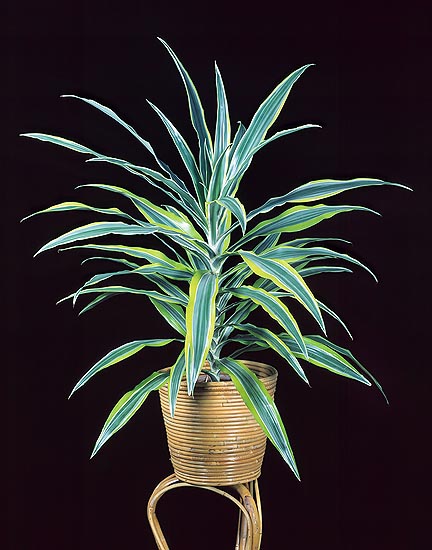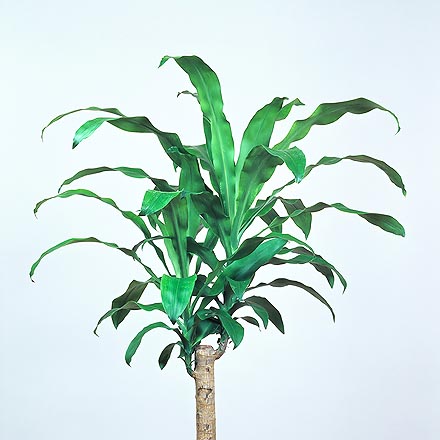Family : Asparagaceae

Text © Pietro Puccio

English translation by Mario Beltramini

A typical indoor plant with countless varieties © Giuseppe Mazza
The Dracaena fragrans (L.) Ker Gawl. (1808) is native to tropical Africa (Angola, Benin, Cameroon, Congo, Ivory Coast, Ethiopia, Gabon, Gambia, Ghana, Guinea, Equatorial Guinea, Kenya, Malawi, Mozambique Sudan, Tanzania, Uganda, Zambia and Zimbabwe).
The name of the genus comes from the Greek “drakàina”, which is the female of dragon; the Latin name of the species, “fragrans” = smelling, fragrant, refers to the scent emanated by the flowers.
Common names: “tronchetto della felicità” (Italian); “corn plant”, “Chinese money tree”, “cornstalk dracaena” (English); “dragonnier”, “porte-bonheur” (French); “Dranchenbaum” (German); “árbol de la felicidad”, “tronco de Brasil”, “palo de Brasil”, “palos de la felicidad”, “dracaena”, “palo de agua”, “carey” (Spanish); “dracaena”, “pau-d’agua”, “coqueiro-de-vênus” (Portuguese).
Shrubby evergreen with erect and not much ramified stems, which, in nature can reach a height of 5-6 m; it shows, on the apexes, tufts of bent leaves, long up to almost 1 m and 10 cm broad, waved on the margins and white or yellow striped in some varieties.
The panicle inflorescences are terminal, 60-80 cm long, with small yellowish-white perfumed flowers. The fruits are spherical berries of orange colour when ripe, about 1,2 cm long.
Plant cultivable in tropical and subtropical humid zones, in semi-shade positions; elsewhere, is to be cultivated in pot, as it does not stand temperatures close to 0°C, and as such, widely utilized for indoor decoration, particularly in the striped leaves varieties.
When in a flat, it is to be placed in a very luminous, but far from direct sun, location, the loam must be draining, in order to avoid and rottenness due to stagnations, and should be maintained constantly humid, but if the plant is placed in a not very luminous and rather cool position, then it is wise to leave it to dry up after each watering.

A Chinese money tree © Giuseppe Mazza
It reproduces by seed, air layering and by parts of stem. The most cultivated varieties are:
‘Massangeana’ characterized by a wide yellow central band with, on the sides, thin green-grey stripes.
‘Lindenii’ with cream white stripes on the edges of the leaf.
‘Victoriae’ with silvery central stripe and pale yellow margins of the leaf.
Synonyms: Aletris fragrans L. (1762); Aloe fragrantissima Jacq. (1762); Pleomele fragrans (L.) Salisb. (1796); Sansevieria fragrans (L.) Jacq. (1801); Cordyline fragrans (L.) Planch. (1850); Dracaena ensifolia var. greigii Regel (1871); Draco fragrans (L.) Kuntze (1891); Dracaena smithii Baker ex Hook.f. (1875); Dracaena lindenii Linden ex André (1880); Dracaena fragrans var. massangeana (Rodigas) E.Morren (1881); Dracaena massangeana Rodigas (1881); Dracaena aureolus W.Bull ex Mast. (1883); Dracaena fragrans f. wacheana Wacha ex Siebert (1895); Dracaena latifolia f. rothiana Siebert (1895); Dracaena steudneri var. kilimandscharica Engl. (1895); Dracaena broomfieldii Sander ex Mast. (1896); Dracaena ugandensis Baker (1898); Dracaena victoria W.Bull (1898); Dracaena janssensii Mast. (1899); Dracaena albanensis Sander ex Mast. (1900); Dracaena deisteliana Engl. (1902); Dracaena deremensis Engl. (1902); Dracaena broomfieldii var. superba Sander ex Mast. (1903); Dracaena butayei De Wild. (1903); Dracaena fragrans var. victoria (W.Bull) O.F.Cook (1903); Dracaena deremensis var. warneckei Engl. (1907); Pleomele deremensis (Engl.) N.E.Br. (1914); Pleomele smithii (Baker ex Hook.f.) N.E.Br. (1914); Pleomele ugandensis (Baker) N.E.Br. (1914).
→ To appreciate the biodiversity within the ASPARAGACEAE family please click here.
